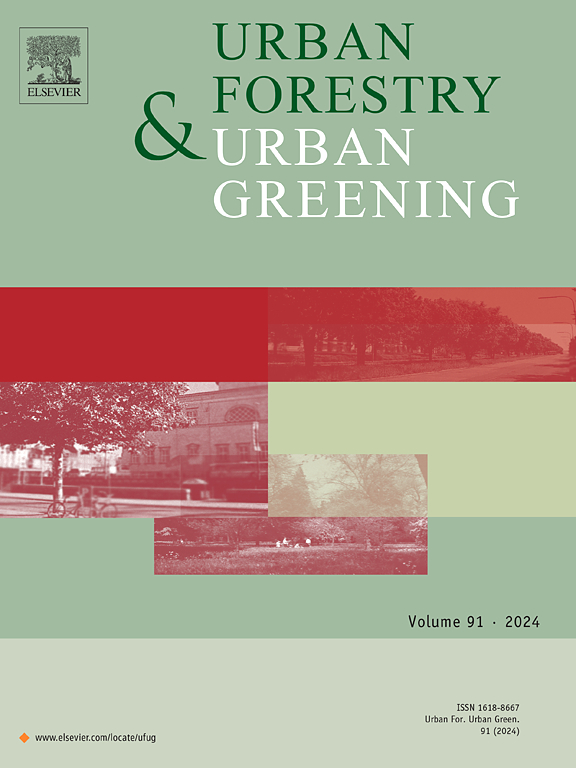高密度城区口袋公园的活力。西南地区用户视角下的评价体系
IF 6
2区 环境科学与生态学
Q1 ENVIRONMENTAL STUDIES
引用次数: 0
摘要
当集中度增加和城市地价上涨时,无论是在新开发项目还是在已建成的地区,实现城市公园都可能变得困难。城市公园的稀缺性导致居民对绿地的可达性降低,导致休闲和健康问题的增加。因此,由于建筑成本低、交通便利、潜在的广泛分布,口袋公园已经成为高密度城市条件下可行和有效的解决方案。尽管对口袋公园的研究越来越多,但很少有研究提出适合中国用户特点的口袋公园评估体系。本文以西南主要城市高密度街区中的袖珍公园为研究对象,从使用者的角度构建了一个评价公园活力的体系。研究的主要数据来源是对公园用户活动模式的现场观察、对用户体验和对公园空间的看法的访谈以及在具有代表性的口袋公园样本中分发的问卷。研究结果表明,设施是影响口袋公园使用的最大因素,超过了自然因素、空间衔接和位置。实际上,口袋公园主要是为居民提供日常锻炼和休闲的场所。低收入群体是公园活动的积极参与者。研究结果提出了一些提高公园效率的设计元素,例如生态效益和功能效用之间的平衡。本文章由计算机程序翻译,如有差异,请以英文原文为准。
The vitality of pocket parks in high-density urban areas. An evaluation system from the users' perspective in Southwest China
When concentration increases and urban land prices rise, the realization of urban parks can be difficult in new developments as well as in established areas. The scarcity of urban parks causes the decrease of residents’ accessibility to green sites, contributing to the increase of recreational and health issues. In response, pocket parks have emerged as a viable and effective solution in high-density urban conditions due to low construction costs, easy accessibility, potential widespread distribution. Although research on pocket parks is growing, very few studies propose an assessment system of pocket parks tailored to the characteristics of Chinese users. This paper explores pocket parks in high-density neighborhoods in the main cities of Southwest China and develops a system for evaluating parks' vitality from the users' perspective. The main data source are on-site observation of the activity patterns of park users, interviews on users’ experiences and perceptions of park spaces, questionnaires distributed within a representative sample of pocket parks. The research findings highlight that facilities are the elements which influence the usage of pocket parks the most, surpassing natural elements, articulation of the spaces, and location. Pocket parks, in fact, primarily provide residents with venues for daily exercise and leisure opportunities. Low-income groups are especially active participants in park’s activities. The findings allow to propose some design elements for improving the parks’ effectiveness, such as a balance between ecological benefits and functional utility.
求助全文
通过发布文献求助,成功后即可免费获取论文全文。
去求助
来源期刊

Urban Forestry & Urban Greening
FORESTRY-
CiteScore
11.70
自引率
12.50%
发文量
289
审稿时长
70 days
期刊介绍:
Urban Forestry and Urban Greening is a refereed, international journal aimed at presenting high-quality research with urban and peri-urban woody and non-woody vegetation and its use, planning, design, establishment and management as its main topics. Urban Forestry and Urban Greening concentrates on all tree-dominated (as joint together in the urban forest) as well as other green resources in and around urban areas, such as woodlands, public and private urban parks and gardens, urban nature areas, street tree and square plantations, botanical gardens and cemeteries.
The journal welcomes basic and applied research papers, as well as review papers and short communications. Contributions should focus on one or more of the following aspects:
-Form and functions of urban forests and other vegetation, including aspects of urban ecology.
-Policy-making, planning and design related to urban forests and other vegetation.
-Selection and establishment of tree resources and other vegetation for urban environments.
-Management of urban forests and other vegetation.
Original contributions of a high academic standard are invited from a wide range of disciplines and fields, including forestry, biology, horticulture, arboriculture, landscape ecology, pathology, soil science, hydrology, landscape architecture, landscape planning, urban planning and design, economics, sociology, environmental psychology, public health, and education.
 求助内容:
求助内容: 应助结果提醒方式:
应助结果提醒方式:


